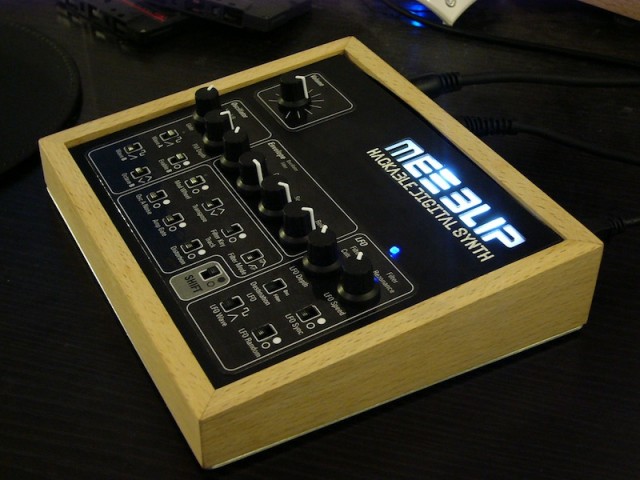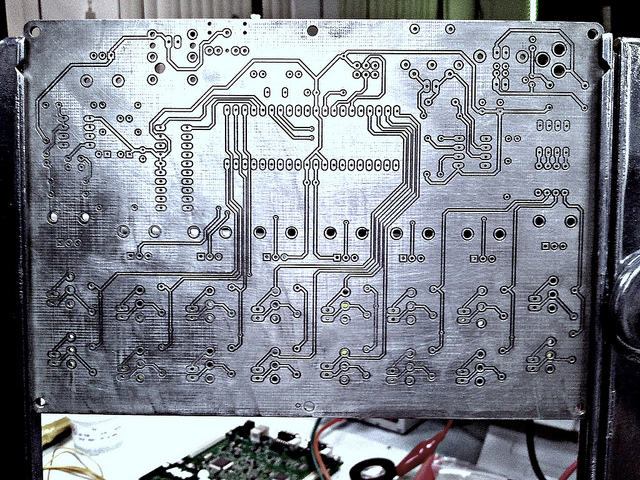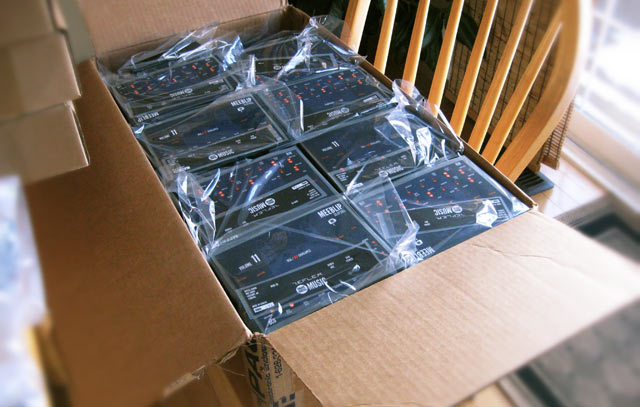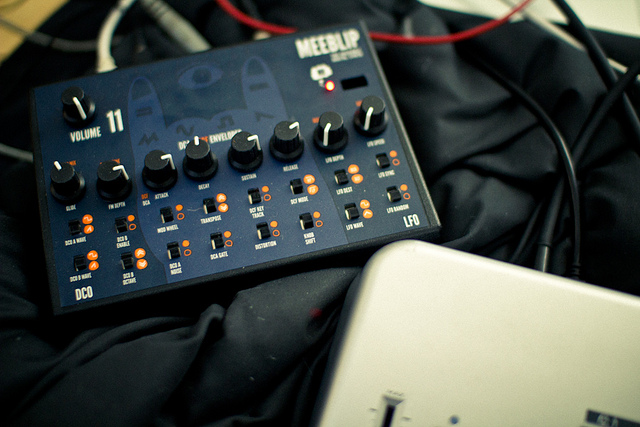We introduced the MeeBlip, an open source, hackable synthesizer, back in early November. Designed by James Grahame of Reflex Audio (and blog Retro Thing) and co-produced with CDM, we placed the hardware and software of the MeeBlip under an open source hardware license, and it was something of an experiment for us. Affordability was paramount – you can get everything you need for $140 US; less if you’re willing to do a little DIY work. Now, the MeeBlip has made its way out into the world and into hands other than just our own, and we’re thrilled to see what people are doing with it.
Here’s a full update on how the MeeBlip project has evolved, the lessons we’ve learned, and how people are assembling, modifying, and – most importantly – playing music with the instrument.
First, I think one of the lovelier things anyone has done is SineSquareSaw’s MeeBlip timelapse construction video – especially with that terrific soundtrack. (He tries the more ambitious route, soldering the DIY kit; we also offer Quick Build versions that require little more than some screws.)
See the really beautiful site, too, http://sinesquaresaw.com/. (We really had nothing to do with this site, so, wow — thanks!)
People Making MeeBlips
Folks building their own MeeBlips did some terrific timelapse video footage of their work as they went. First up, the DIY Kit – the one that actually requires soldering:
Marcos has a great timelapse up of the MeeBlip DIY, too, and writes, “Me he hecho un sinte de meeblip con los componentes pre-programados y una placa que he pedido por internet a canadá y la verdad es que el resultado es cojonudo.” I’ve now learned the word cojonudo.
Cane Creek, above, has a terrific soundtrack and video in his build, which demonstrates the Quick Build kit – no soldering. Since that process is quicker, it leaves him time to fiddle around with making some nice noises!

Michael Roebbeling, embarking on what he describes as his first electronics project ever, managed nonetheless to build a breathtakingly-pretty case for his MeeBlip. (To my mind, this is the best-looking MeeBlip on Earth, presently. Kudos, Michael!) He describes the whole process on his blog.
Because it’s open source, some people are making, not buying, their MeeBlips. It’s definitely the hard way to go (and not necessarily cheaper), but it’s nonetheless gratifying to see people braving it! Oh, and it makes for some really pretty circuit boards.

Two examples from the Noisepages group, which also link to some documentation:
Building myself a MeeBlip – the hard way by Krzysztof Konatowicz
made a meeblip (Charlie also has some tips on through-hole plating!)
People Playing MeeBlips
I think when people see kits and hear the words “open source” or “hackable,” they may imagine that this is just a project for tinkerers, not musicians. On the contrary, I think part of why James and I were enthusiastic about trying this at all was that we wanted to make something we could play, and that others could pick up and play — better.
Early videos, naturally, are generally of the “fiddling about” variety, but we have even had some genuine performances. Either way, you get to hear some noises.
gex0008 makes some deliciously raunchy, lo-fi videos with the Yamaha QY10, itself a quite-nice mobile Yamaha sequencer workstation. (Ever get the feeling that some of the most useful music gear is now discontinued?)
James Veeder does some extensive experimentation with the MeeBlip. He intentionally pushes it to some noisy places, but for the record, yes, the noise you hear when there aren’t any notes is USB power. (And James has what has to be the noisiest USB source I’ve ever heard! If you like this sort of thing, you can still hook up USB on the DIY kit; we’ve since switched to 9V and now offer that both on all currently-shipping MeeBlips and as a retrofit if you have a USB MeeBlip Quick Build and want to switch. See below…)
Johan Larsby got a MeeBlip and a Rock Band 3 “keytar” controller, so naturally put them together; see below. (As it happens, the Rock band keyboard has been a favorite for both James and myself working with the MeeBlip; the scale relates nicely.)
Hands-on impressions
We’ve had a number of blog reviews, including:
All Hail the Meeblip [wildfreshness]
Quick Look: MEEBLIP Mono Digital Synth Module [Technobrains]
The one person I’ve seen really incorporate the MeeBlip into a performance is Chris Randall of Analog Industries / micronaut / Audio Damage. Here’s a first test of a MeeBlip and RE-201.
Micronaut v MeeBlip by Chris Randall
(The noise issue heard in the sample we’ve resolved.)
Aside from writing a (fair, I think) review, he’s got the MeeBlip as part of a hardware rig that includes some much pricier gear. In this video, he creates a really gorgeous jam soloing on the MeeBlip via a Manta touch controller. Oh, and there’s an Apple II. Seriously.
As with the previous video, the Apple //e with Roland CMU-800R is in the driver’s seat. It is providing the drums with its internal sounds, and is controlling the modular synth, the Korg MS-20, and the Yamaha CS-5 (out of frame underneath the MS-20) via CV/Gate.
The main melody line that comes in after a bit is coming from a Reflex MeeBlip, which you can just see sitting on the desk. I’m controlling it with a Snyderphonics Manta controller.
Effects used: Roland RE-201 Space Echo, Eventide TimeFactor delay, Realistic Electronic Reverb delay, Audio Damage Eos reverb, Lexicon 300 reverb.
Chris incorporates this into a very nice and tidy performance rig, which in turn he used live in LA for a live PA set. Documentation:
[Another] Science Project
The rig: Great Taste, Less Filling…
The MeeBlip is somewhere on the resulting live set, which Chris has released. I’m not really concerned about where it is, though; at that point, I’m more interested in the music, which in this case I find terrific. I wish I could’ve seen it live.
This has honestly been what’s been most exciting to me, is the bigger picture beyond the MeeBlip. We’re seeing people embrace all sorts of affordable hardware. The MeeBlip has already been found alongside the Shruthi-1 from Mutable instruments, another open-leaning project. (While not open source hardware, the Shruthi does include open source firmware.)
However they happen to do it – MeeBlip or otherwise – the idea of more people using affordable synths, exploring synthesis, and getting a taste of customizing hardware and software or building their own makes me very happy indeed.
Of course, I’m also really happy to have a MeeBlip to play with in my own home. One recent example, for which I shared a patch via our “hipster preset storage” (i.e., writing with a pen):
Hint: adding effects is a good idea with this kind of synth. (It’s true of many vintage synths, as well.)
The Softer, Pad-ier Side of MeeBlip: A Patch, Some Music
Here’s a bassline made by James (see details from the blog):
Updates to the Project
With any new launch, there will be some bumps and improvements. I told James early on that one goal I had was sharing everything we learned, knowing that there are CDM readers also working on making their own hardware and other creations. (And yes, we still want to support you, too.)

We’ve made some adjustments as we go, and – as planned – kept a steady diet of firmware updates:
Manufacturing start-up and shipping initially lagged sales, but MeeBlips are now shipping more quickly. James wrote a detailed post on the MeeBlip blog that’s a must-read if you’re mulling open-source hardware, but the short version is this: unanticipated high demand for the MeeBlip, case-machining delays, and slow, by-hand, micro-manufacturing meant we didn’t ship the MeeBlip as quickly as we would have liked. As the project is growing, though, we’re gradually improving the production workflow. It’s a good read if you’re making – well, anything, not just synths. See also Michael Una, Beep-It’s maker, and drum machine and guitar effect legend Roger Linn on DIY manufacture and its risks. It’s important to me to see the MeeBlip continue to grow, because it means we can do more with the project.
USB power sucks. USB power is too noisy in most of the ways you’d normally get it. Long story short: we’re switching to 9V power. Existing Quick Build MeeBlips can be easily retrofitted, DIY MeeBlips already have 9V power (as well as USB), and all currently-shipping MeeBlips now have 9V power.
We’ve got new firmware with new features. The January update added a PWM waveform with dedicated LFO sweep, better performance, and fixes; the February update improved knob function and added full auto-save of knob settings. I wrote a tutorial on how to update your firmware, and we added an option to let you buy a chip with the work done for you.
But the next big improvement could come from you. Next on our plate is making it easier to use the open source software part of the MeeBlip, by providing tutorials for how to make firmware modifications yourself.
Of course, modding the MeeBlip isn’t at all essential to enjoying the thing. I’m equally excited about those features as I am the way in which people use the MeeBlip in their music.
And naturally, if you’re doing interesting things with synths – any synths – we’d love to hear about it.

